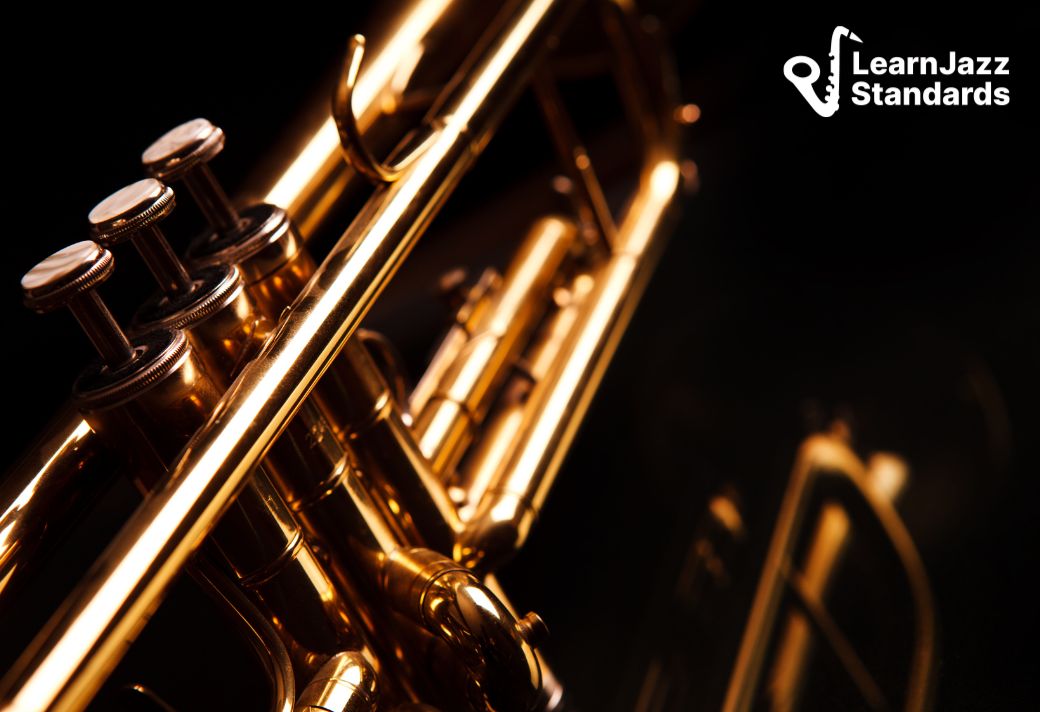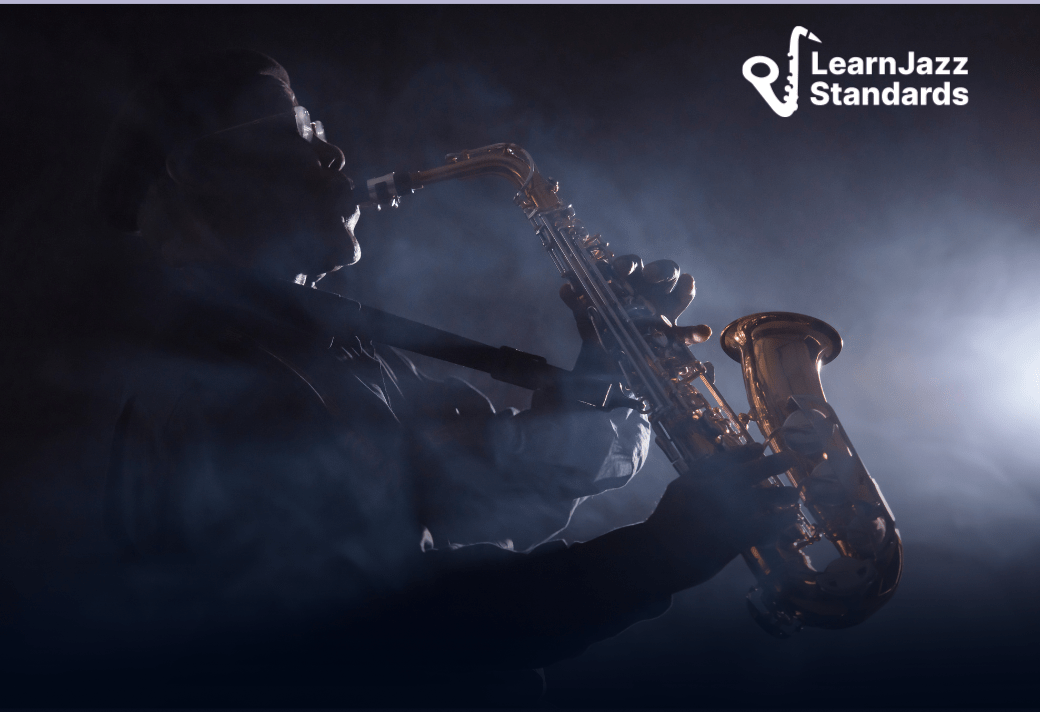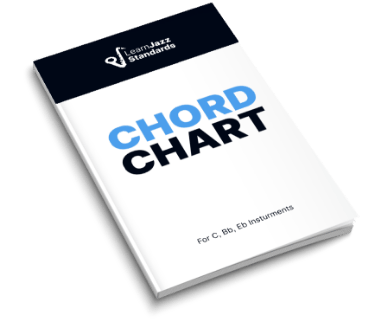If you’ve studied jazz for a while, it won’t be long before you discover the concept of the “backdoor progression.” It is an important chord progression that takes the listener through a “backdoor” to a target chord instead of going through the regular dominant or V chord.
In this article, we’ll learn all about this non-diatonic chord progression that jazz players use to infuse their playing with variety. This progression is quite common and can be heard in many classic jazz standards, so it’s one you should know if you want to master the jazz language.
We’ll discuss the backdoor progression’s two forms and learn how and why it works in jazz music. We’ll also dig into the music theory behind it so you understand the backdoor cadence theoretically. Then, we’ll look at five real examples of the backdoor progression in jazz tunes you love!
If you want to master jazz chord progressions like the backdoor progression and become the best jazz player you can be, check out the Learn Jazz Standards Inner Circle. We have everything you need to take your playing to the next level.
Improve in 30 Days or Less. Join the Inner Circle.
Table of Contents
What Is The Backdoor Progression?
The backdoor progression is non-diatonic, which means that some of the notes within the progression can come from outside the key signature. For example, in the key of C major, the backdoor ii-V progression would be F-7 to Bb7, which resolves to a C major chord.
Check out this article for more on diatonic chords.
F-7 and Bb7 contain pitches that are not in the C major key signature. Therefore, these chords are non-diatonic. Below, we have a backdoor progression in the key of C major. Notice how the F-9 chord contains an Eb and Ab, and the Bb13 chord contains an Ab and a Bb.
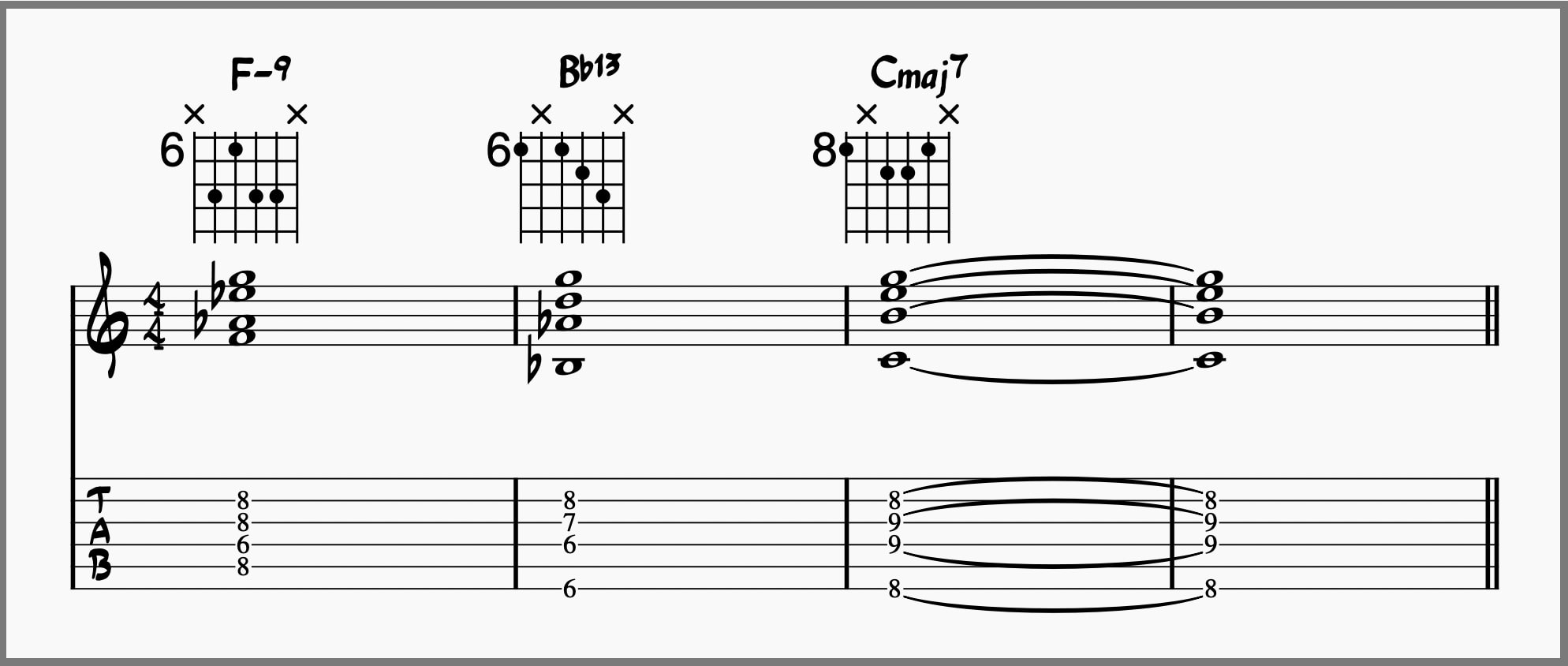
These chord tones are nowhere to be found in the key of C major, which has E naturals, A naturals, and B naturals. However, there is a key that has three flats, and it can help us understand where the backdoor progression comes from.
Readers who are sharp on music theory might realize these three flats belong to the key of C minor.
Therefore, these chords are borrowed from the parallel minor key of C minor.
Parallel minor keys share a root note with their major counterparts. Unlike relative major and minor, they do not share a key signature.
Here is a harmonized C major scale, which shows the diatonic chords in the key of C major:

Here are the diatonic chords in the parallel minor key of C minor. Notice the iv and the VII chords boxed off in pink. These are the backdoor progression chords! The minor iv and dominant VII chords are borrowed for the backdoor ii-V progression. Notice the ii-V relationship between F-7 and Bb7.

Check out this article for more on parallel minor keys.
Therefore, the backdoor progression is a chord substitution, like a tritone substitution or diminished chord substitution. However, chords in a backdoor progression are borrowed from the parallel minor key and resolve back to a target chord (usually the tonic chord, but it doesn’t have to be).
Check out these articles to learn more about tritone substitutions, chord substitutions, and borrowed chords.
The Two Forms of the Backdoor Progression
Before we learn how the backdoor substitution works in theory, we need to recognize the two forms backdoor progressions can take.
Backdoor chord progressions can take the following forms:
1. One Chord Form: The Backdoor Dominant Chord (bVII7)
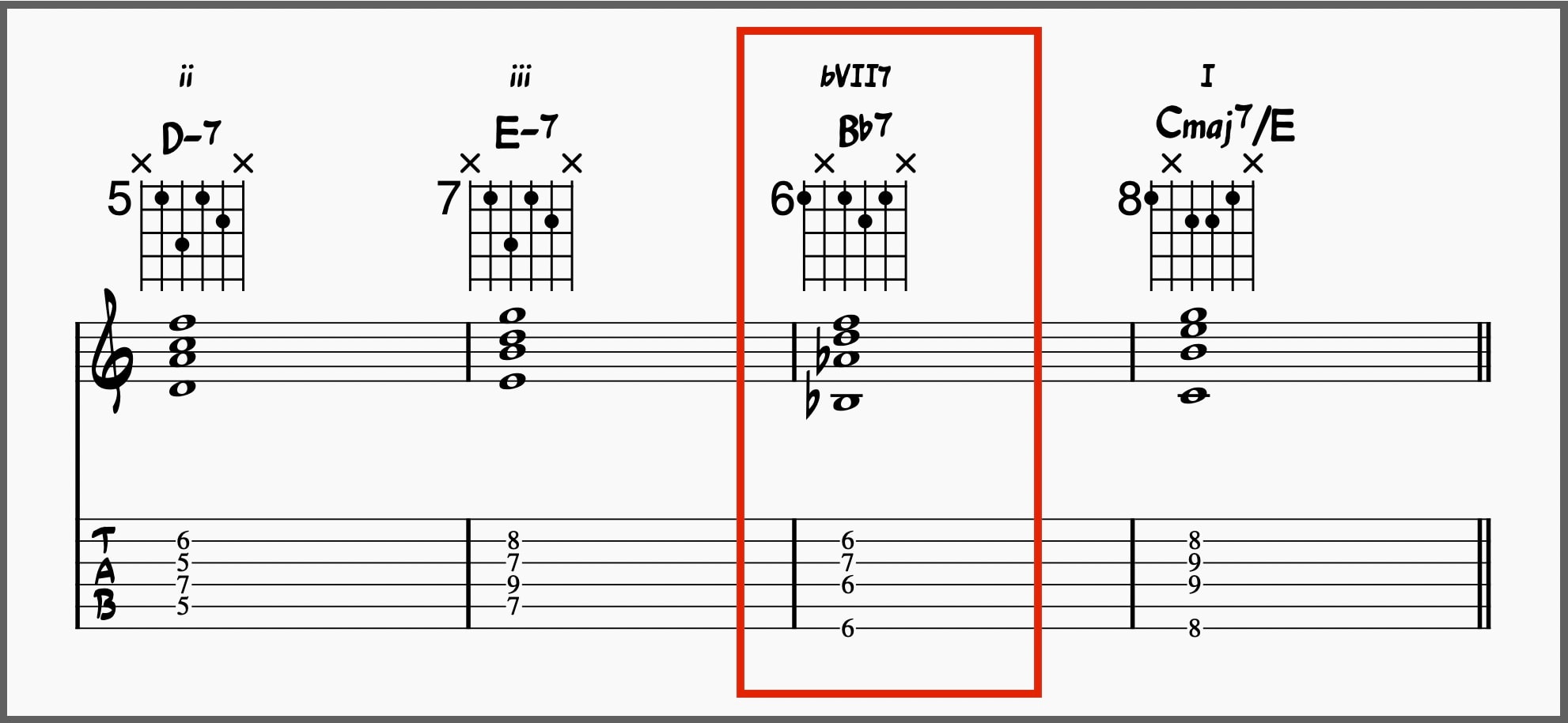
A backdoor dominant chord is a dominant seventh chord whose root is a whole step below the target chord (usually the I chord). Using Roman numeral analysis, we can call this the bVII chord.
Take note that this V chord doesn’t resolve where you’d expect. Normally, we’d expect a Bb7 chord to resolve up a fourth or down a fifth to an Ebmaj7 chord. However, the Bb7 chord resolves up a whole step to Cmaj7 instead.
The only alteration this dominant seventh chord usually receives is a #11, which works because it is the 3rd of the target chord. The #11 of Bb7 is E, and E is the 3rd of our tonic chord C.
2. Two Chords: The Backdoor ii-V Progression (iv-bVII7)
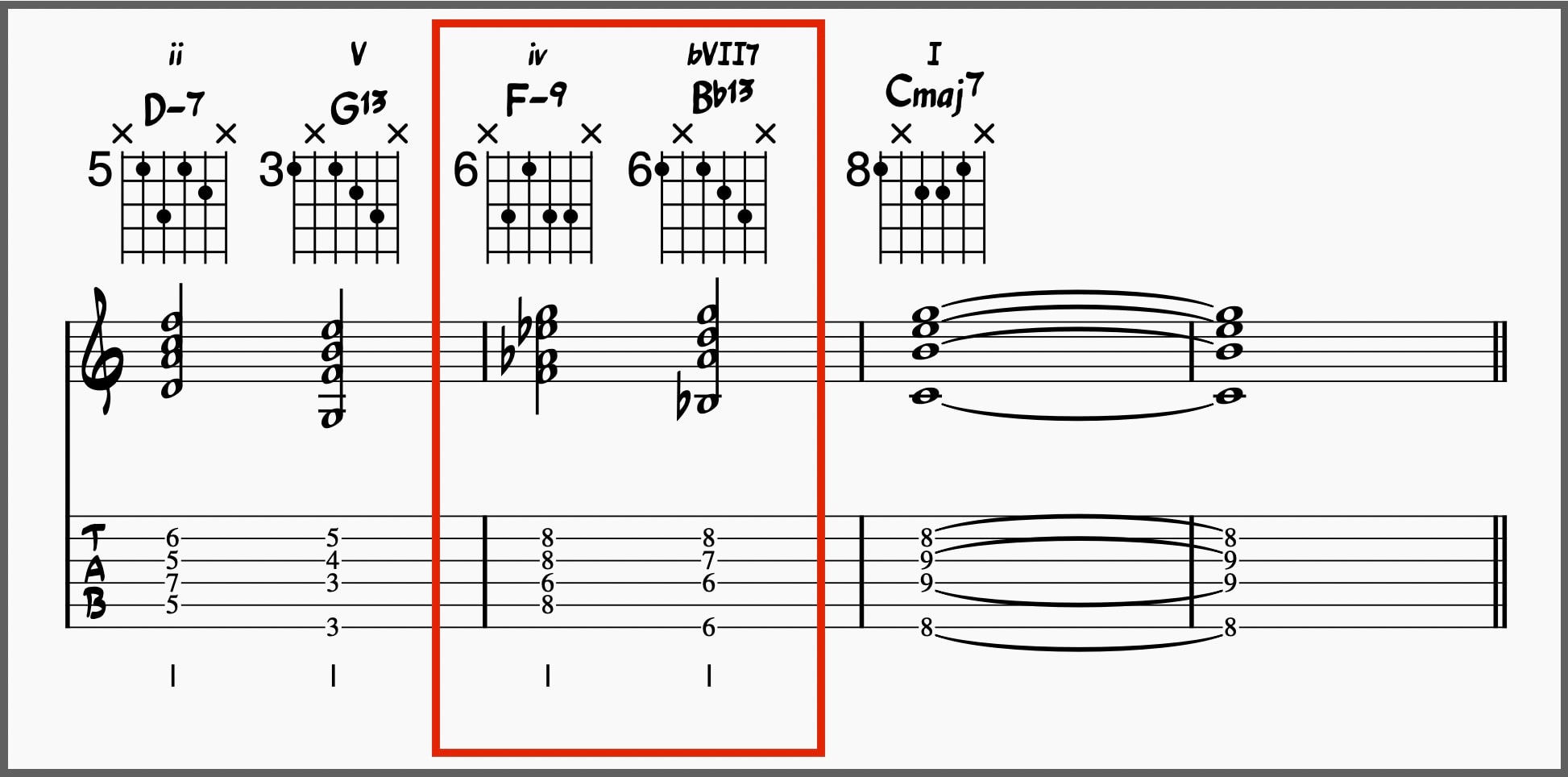
Sometimes, the backdoor dominant chord can be preceded by a ii chord. This is the backdoor ii-V progression. It features both the minor iv chord (the ii) and the bVII chord (the V).
Like the sole Bb7 backdoor chord from the previous example, this ii-V doesn’t resolve to the I chord you’d expect. Typically, an F-7 to Bb7 would resolve to an Ebmaj7, but we resolve up a whole step to Cmaj7.
BEFORE YOU CONTINUE...
If music theory has always seemed confusing to you and you wish someone would make it feel simple, our free guide will help you unlock jazz theory secrets.

Why Does The Backdoor Progression Work?

image source: Wikimedia Commons
The backdoor progression works because of the voice leading of the chord tones in the progression.
The minor iv chord is a common chord substitution in jazz music. Usually, it replaces the IV chord of a standard plagal cadence, a diatonic IV-I chord progression.
Check out this article for more on musical cadences.
However, the minor iv chord is non-diatonic, so it contains notes from outside the scale. Compare the diatonic plagal cadence to the non-diatonic version below.
Plagal Cadence
I used particular voicings that kept the notes that changed on the inside and those that stayed the same on the outside. With our diatonic chord progression, we have nice stepwise motion between the moving voices.

Minor Plagal Cadence
I used similar voicings for this first example of a minor plagal cadence. When changing from an Fmaj7 to an F-7, our E becomes an Eb, and our A becomes an Ab. This leads to nice chromatic half-step motion from the Eb to the E and stepwise from F to G and Ab to Bb.

Using another voicing for F-7, we can get nice chromatic movement from Eb to E, C to B, and Ab to G.

Despite being non-diatonic, the iv to I chord resolution works because of the smooth voice leading between the chord tones of each chord. However, that’s only half of our backdoor ii-V! We also need to consider our backdoor dominant chord.
Voice Leading From the Backdoor Dominant Chord
The iv to I minor plagal cadence is a very satisfying chord resolution, but many jazz musicians take it to the next level by adding a V chord or a dominant seventh chord. This creates our backdoor ii-V chord progression.
Looking at the example below, you can see how the chord tones in a Bb7 chord can resolve to a C chord. Consider how the chord tones resolve to a Cmaj7 chord as well. Despite which version of a I chord you resolve to, there are plenty of great step-wise opportunities for good voice leading.

The backdoor dominant chord, backdoor ii-V, and minor iv chord work well because the voice leading to the I chord is smooth and sounds great.
Check out this article for more on good voice leading in music.
As a player, you have flexibility when encountering a minor seventh or dominant seventh chord. If you encounter a minor seventh chord, you can imply a ii-V by adding a dominant chord a fifth below or a fourth above.
Likewise, when you encounter a dominant chord, you can often precede it with its “ii” chord a fourth below or a fifth above.
Another Explanation For Why the Backdoor Dominant Chord Works
There is another way to view the function of a bVII7 chord—as a darker chord substitution for the V chord. The bVII7 and V chords are closely related because a bVII is the upper extension of a V chord but with a b3 instead of a natural 3.
In fact, G7 and Bb7 share two of the same notes. Also, the Ab and Bb in our Bb7 can be considered the b9 and the #9 of an altered G7 chord.

G7 Chord
- 7th: F
- 5th: D
- 3rd: B
- Rt: G
Bb7 Chord
- 7th: Ab
- 5th: F
- 3rd: D
- Rt: Bb
Therefore, the bVII chord could also be a chord substitution for the V chord because it shares many of the same notes and contains the alterations b9 and #9.
Check out this article for more on chord extensions and alterations.
5 Jazz Standards That Use the Backdoor Progression
Let’s explore five real-world examples of the backdoor progression in jazz standards. We’ll look at the chord progressions of five jazz tunes and talk about the backdoor progressions within them!
1. Stella By Starlight
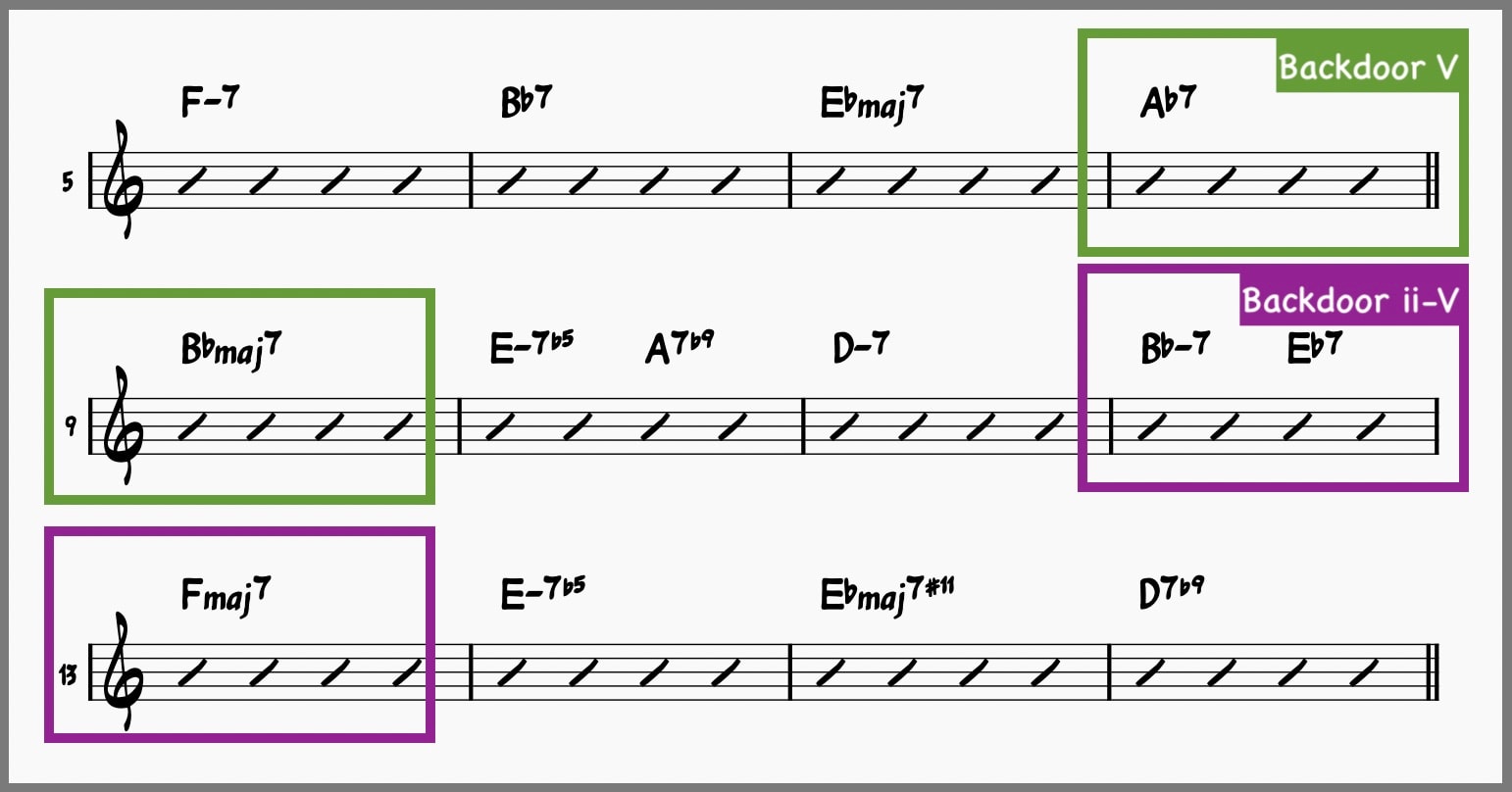
“Stella by Starlight” features both a backdoor dominant chord and a backdoor ii-V progression. The backdoor dominant chord is in eight and resolves in bar nine. The backdoor ii-V starts in measure twelve and resolves in measure thirteen.
2. How Deep is the Ocean
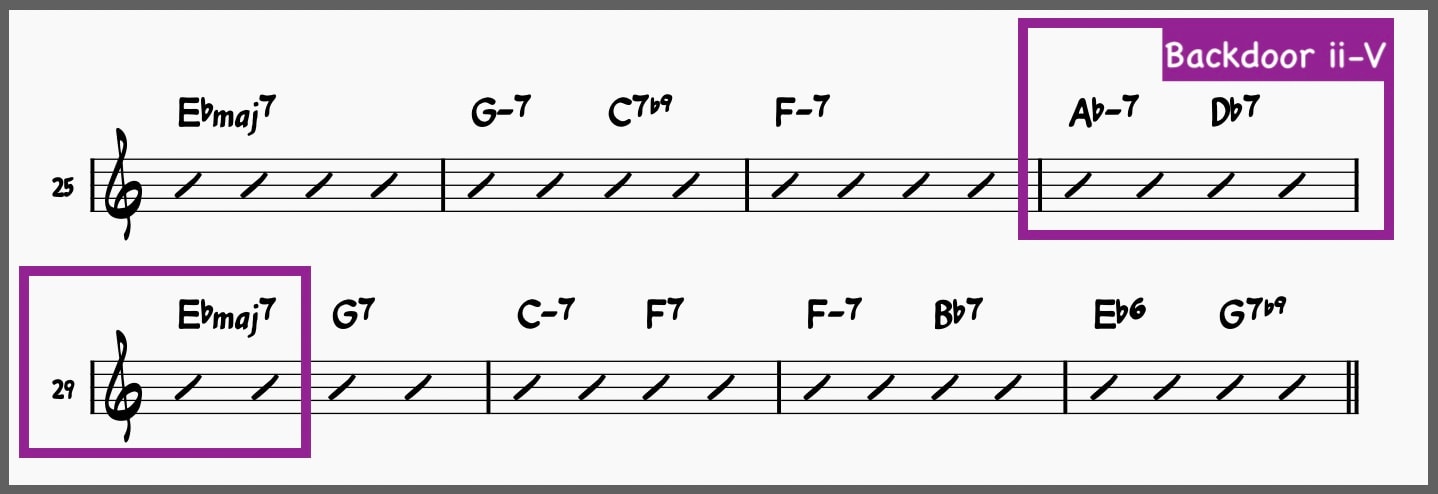
“How Deep is the Ocean” has a backdoor ii-V progression starting in measure twenty-eight and resolving in measure twenty-nine.
3. Yardbird Suite
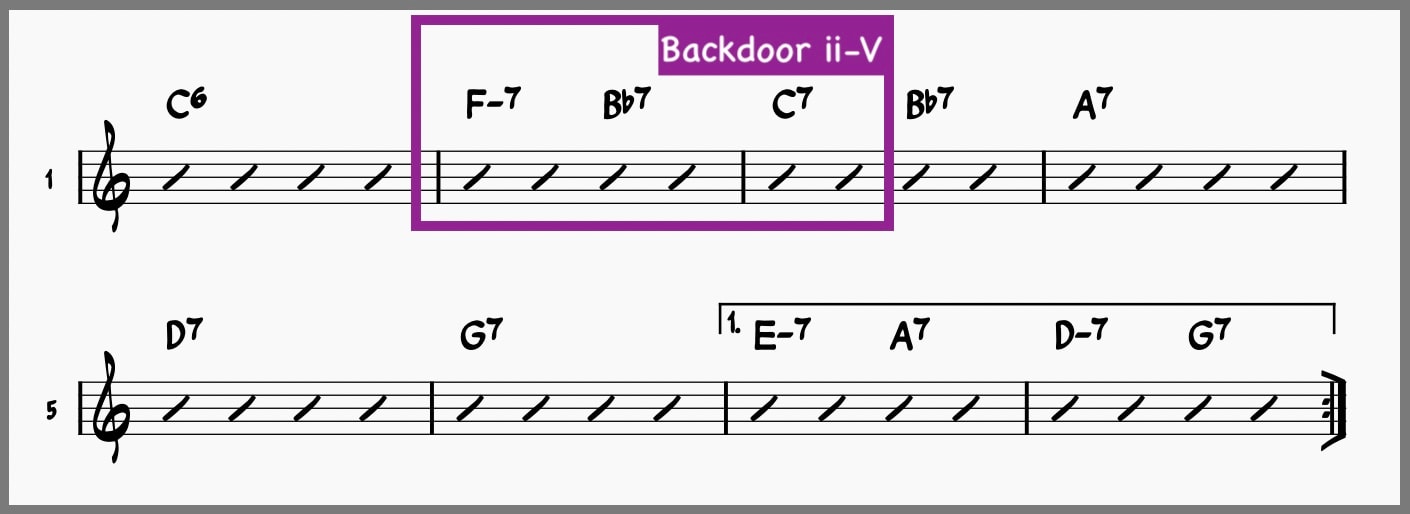
“Yardbird Suite” has a few backdoor ii-Vs throughout the form. Because it’s an AABA song form, the backdoor progression appears three times in the second and third measure of each A section. Also, notice the iii-vi-ii-V turnaround progression at the end!
Check out this article on jazz turnarounds for more information!
Unlike our other examples, the backdoor dominant chord in this example doesn’t resolve to a C maj7 chord or I chord. Instead, this backdoor resolves to a C7 chord or I7 chord. Remember that backdoor dominant chords don’t have to resolve to a I maj7 chord.
From the fourth measure onward, we get a series of secondary dominant chords. Secondary dominant chords are another important chord substitution you should know.
Check out this article for more on secondary dominants.
4. Just Friends

“Just Friends” has a backdoor ii-V in the A section starting in the third measure and lasting through the sixth.
5. Misty
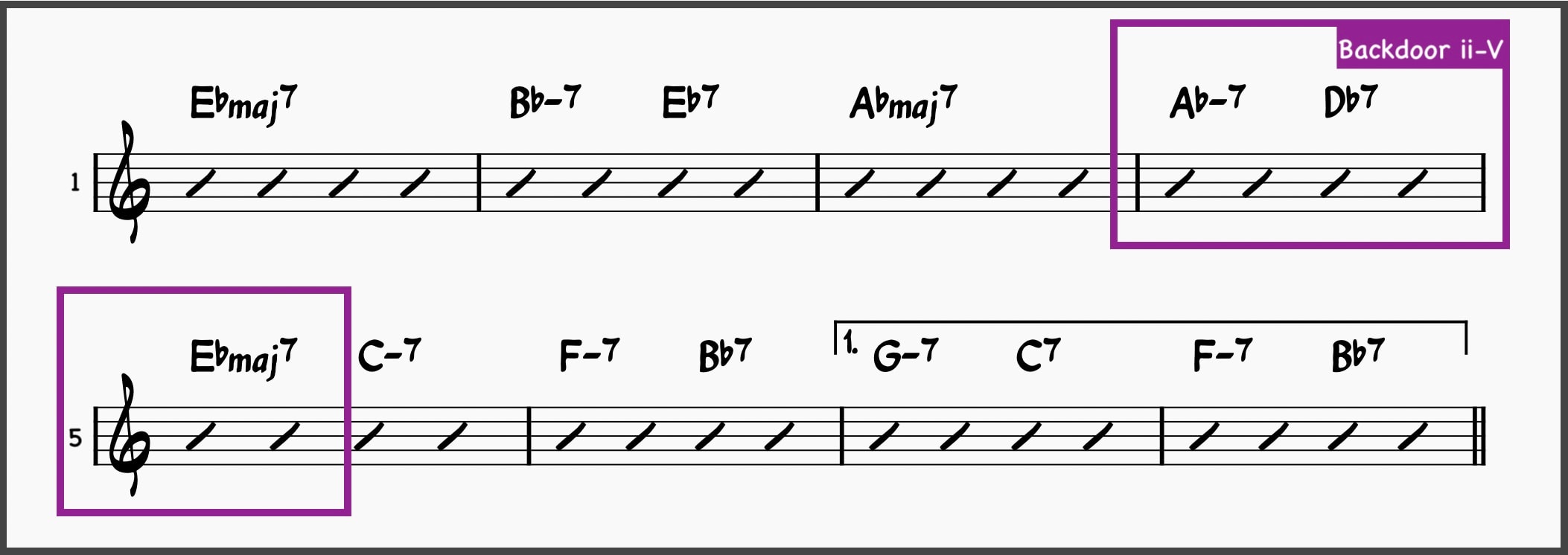
“Misty” has a backdoor progression in the fourth and fifth measures of the A section. The form is AABA, so this backdoor progression occurs three times in every chorus.
If you want to learn more about jazz theory, jazz harmony, and improvisation, check out this ultimate guide to jazz theory.
Practicing the Backdoor Progression
The key to practicing the backdoor progression is to isolate it, slow it down, and practice developing melodies that use strong guide tones to resolve from the backdoor dominant 7th chord into the target major chord.
Here are three lines you can play over the backdoor progression.
Example 1

Example 2

Example 3

If you are a chordal instrumentalist, play the backdoor cadence in all twelve keys! Choose inversions and voicings that have strong voice leading! The best voice-leading options are the b7th of the bVII7 to the 5th of the I chord and the 5th of the bVII7 to the 3rd of the I chord.
Take Your Jazz Theory to the Next Level. Join The Inner Circle.
The Learn Jazz Standards Inner Circle helps you take your jazz playing and theory chops to the next level! If you want to seriously overhaul your jazz playing, check out the Inner Circle.
Improve in 30 Days or Less. Join the Inner Circle.



